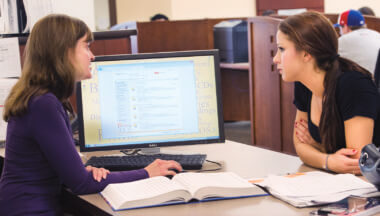 West Virginia University, located in Morgantown, WV, is a Films On Demand subscriber. We recently talked with Beth Jane Toren, WVU Libraries’ Media and Research Services Librarian, about how her library handles technophobes, accommodates disabled students and faculty, and encourages usage among researchers.
West Virginia University, located in Morgantown, WV, is a Films On Demand subscriber. We recently talked with Beth Jane Toren, WVU Libraries’ Media and Research Services Librarian, about how her library handles technophobes, accommodates disabled students and faculty, and encourages usage among researchers.
Tell us one way you’re helping users who may be hesitant to embrace technology to take advantage of your library’s online resources.
My first rule is to never tell them how easy it is. That’s the type of thing that should be a great reward when it happens for them. If it doesn’t, being told it is easy and then struggling can be a great way to become “hesitant to embrace” that experience again. I create a no-blame, no-pressure, supportive environment, empathize with their reluctance, and give lots of assurance and as much handholding as needed. To accomplish this, I make sure the main takeaway from my interactions is that we are here to assist them when they need us and to make sure they know how to reach us. I emphasize the friendly and useful features of technology that they are most familiar with and tell them to remember what it can do if they ever need it, letting them know that we are available to assist them in learning to use the features if they decide they are interested. I introduce names of things that may be new to them slowly, avoiding jargon and relating it to things they already understand. For example, if they aren’t used to saving digital documents in a folder, I compare the folder to the shopping cart when they shop online or in real life.
In the academic library we are most likely to encounter users reluctant to embrace antiquated technology. I give lots of assurance that it’s not them, that there really is such an enormous amount of technology and it changes so rapidly, that it is hard and unnecessary to keep up, and that the best way to manage this is to become comfortable with uncertainty. I encourage them to get out of their comfort zone because that is how we grow and learn.
What have you done that has most impacted usage at your college?
I’ve occasionally written press releases for new products and services, but I think getting people in a room at local conferences to show and tell, and answering questions about how they might use these things—that is the most effective. People are so overwhelmed with emails and news, I think the workshop topics are more likely to stick—especially if you can get them engaged in a discussion about how they might use it. And I always workshop their topics rather than demonstrate a canned search or presentation. If problems arise, as they often do, that is relatable and part of the demo is working through it. That goes back to making reluctant people comfortable. We all need to relax when things don’t work, keep experimenting, and not get discouraged or give up. I give them the takeaway that I am available to follow up and assist when they get around to using the product or service in the future.
How do you alert faculty to the new resources your library acquires?
Our library has many marketing techniques including press releases, website ads, a news library blog, social media, posters, handouts, and info-stations. Individual librarians also email departments and individuals they know may be interested and encourage sharing with their colleagues.
How do you make sure students and faculty with disabilities or language barriers can easily access your library’s resources?
We follow standards for universal design. No one is singled out with special versions or equipment. The principle works across many design areas and makes life easier for everyone. Ramps on sidewalk corners are friendly for people on wheels and on foot.
What do you think is the library’s most important responsibility at your institution?
To identify, provide, and respond to our community’s groups’ and individuals’ needs; be their third place that supports education with collections, facilities, and services; and make ourselves known as that place. We emphasize how our mission ties in with that of the University, with teaching, service and research, and the three pillars of education, health care, and prosperity. We make sure that big picture is also applied to the needs of each individual user.
Tell us about your favorite YouTube video/libguide, etc., your library has created to promote a resource.
For a website launch, our college radio station created a public service announcement with jazz in the background and an enthusiastic and very dramatic student addressing the students and making it sound like visiting our website was like listening to jazz at the beach! It was very short, but their hearts were in it, and it reached a lot of students. It was free for us, and they got experience applying their skills to a real-life project. It was a big win-win!


